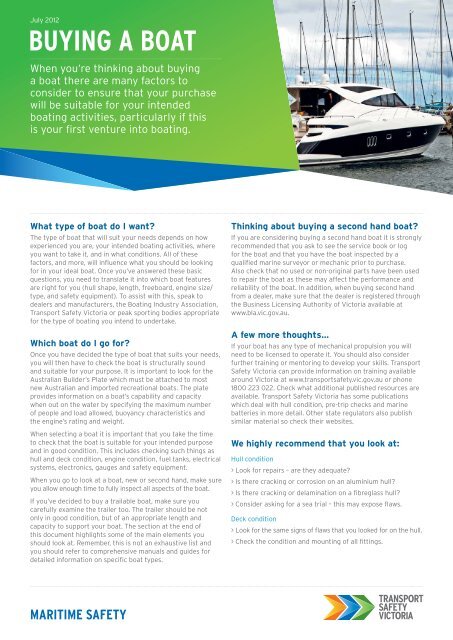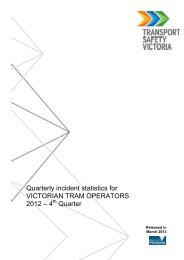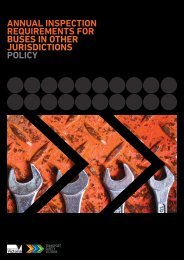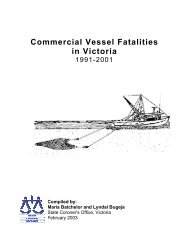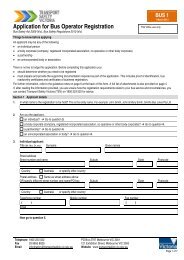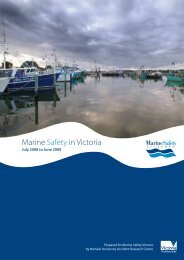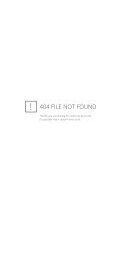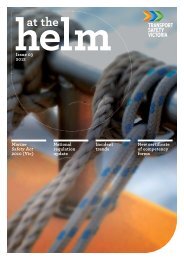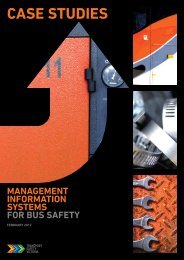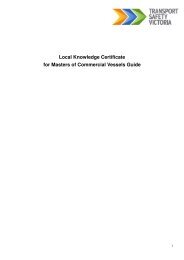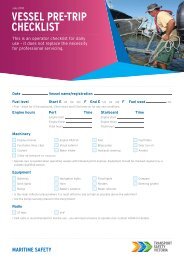Buying a boat (PDF, 168.4 KB, 2 pp.) - Transport Safety Victoria
Buying a boat (PDF, 168.4 KB, 2 pp.) - Transport Safety Victoria
Buying a boat (PDF, 168.4 KB, 2 pp.) - Transport Safety Victoria
You also want an ePaper? Increase the reach of your titles
YUMPU automatically turns print PDFs into web optimized ePapers that Google loves.
July 2012<br />
BUYING A BOAT<br />
When you’re thinking about buying<br />
a <strong>boat</strong> there are many factors to<br />
consider to ensure that your purchase<br />
will be suitable for your intended<br />
<strong>boat</strong>ing activities, particularly if this<br />
is your first venture into <strong>boat</strong>ing.<br />
What type of <strong>boat</strong> do I want?<br />
The type of <strong>boat</strong> that will suit your needs depends on how<br />
experienced you are, your intended <strong>boat</strong>ing activities, where<br />
you want to take it, and in what conditions. All of these<br />
factors, and more, will influence what you should be looking<br />
for in your ideal <strong>boat</strong>. Once you’ve answered these basic<br />
questions, you need to translate it into which <strong>boat</strong> features<br />
are right for you (hull shape, length, freeboard, engine size/<br />
type, and safety equipment). To assist with this, speak to<br />
dealers and manufacturers, the Boating Industry Association,<br />
<strong>Transport</strong> <strong>Safety</strong> <strong>Victoria</strong> or peak sporting bodies a<strong>pp</strong>ropriate<br />
for the type of <strong>boat</strong>ing you intend to undertake.<br />
Which <strong>boat</strong> do I go for?<br />
Once you have decided the type of <strong>boat</strong> that suits your needs,<br />
you will then have to check the <strong>boat</strong> is structurally sound<br />
and suitable for your purpose. It is important to look for the<br />
Australian Builder’s Plate which must be attached to most<br />
new Australian and imported recreational <strong>boat</strong>s. The plate<br />
provides information on a <strong>boat</strong>’s capability and capacity<br />
when out on the water by specifying the maximum number<br />
of people and load allowed, buoyancy characteristics and<br />
the engine’s rating and weight.<br />
When selecting a <strong>boat</strong> it is important that you take the time<br />
to check that the <strong>boat</strong> is suitable for your intended purpose<br />
and in good condition. This includes checking such things as<br />
hull and deck condition, engine condition, fuel tanks, electrical<br />
systems, electronics, gauges and safety equipment.<br />
When you go to look at a <strong>boat</strong>, new or second hand, make sure<br />
you allow enough time to fully inspect all aspects of the <strong>boat</strong>.<br />
If you’ve decided to buy a trailable <strong>boat</strong>, make sure you<br />
carefully examine the trailer too. The trailer should be not<br />
only in good condition, but of an a<strong>pp</strong>ropriate length and<br />
capacity to su<strong>pp</strong>ort your <strong>boat</strong>. The section at the end of<br />
this document highlights some of the main elements you<br />
should look at. Remember, this is not an exhaustive list and<br />
you should refer to comprehensive manuals and guides for<br />
detailed information on specific <strong>boat</strong> types.<br />
Thinking about buying a second hand <strong>boat</strong>?<br />
If you are considering buying a second hand <strong>boat</strong> it is strongly<br />
recommended that you ask to see the service book or log<br />
for the <strong>boat</strong> and that you have the <strong>boat</strong> inspected by a<br />
qualified marine surveyor or mechanic prior to purchase.<br />
Also check that no used or non-original parts have been used<br />
to repair the <strong>boat</strong> as these may affect the performance and<br />
reliability of the <strong>boat</strong>. In addition, when buying second hand<br />
from a dealer, make sure that the dealer is registered through<br />
the Business Licensing Authority of <strong>Victoria</strong> available at<br />
www.bla.vic.gov.au.<br />
A few more thoughts…<br />
If your <strong>boat</strong> has any type of mechanical propulsion you will<br />
need to be licensed to operate it. You should also consider<br />
further training or mentoring to develop your skills. <strong>Transport</strong><br />
<strong>Safety</strong> <strong>Victoria</strong> can provide information on training available<br />
around <strong>Victoria</strong> at www.transportsafety.vic.gov.au or phone<br />
1800 223 022. Check what additional published resources are<br />
available. <strong>Transport</strong> <strong>Safety</strong> <strong>Victoria</strong> has some publications<br />
which deal with hull condition, pre-trip checks and marine<br />
batteries in more detail. Other state regulators also publish<br />
similar material so check their websites.<br />
We highly recommend that you look at:<br />
Hull condition<br />
> Look for repairs – are they adequate?<br />
> Is there cracking or corrosion on an aluminium hull?<br />
> Is there cracking or delamination on a fibreglass hull?<br />
> Consider asking for a sea trial – this may expose flaws.<br />
Deck condition<br />
> Look for the same signs of flaws that you looked for on the hull.<br />
> Check the condition and mounting of all fittings.<br />
MARITIME SAFETY
We highly recommend that you look at:<br />
(continued)<br />
Engine condition<br />
> Is the engine of a suitable size and power output for the<br />
<strong>boat</strong>? Remember that, for any given power output, a<br />
4-stroke engine will usually be heavier and more bulky than<br />
a 2-stroke engine but may be more economical and reliable.<br />
> Check whether the engine starts and runs smoothly,<br />
cold and hot.<br />
> Engaging a marine mechanic is recommended to inspect<br />
the engine for you.<br />
Fuel systems<br />
> Check for corrosion, cracks and leaks in hoses and fastenings.<br />
> Are fuel tanks easily accessible for inspection?<br />
> Don’t forget to check ancillary fuel systems such as cooking<br />
and heating.<br />
> It is highly recommended that expert advice is sought from<br />
a marine mechanic specialising in engine installation and<br />
maintenance when buying a <strong>boat</strong> powered by an inboard<br />
petrol engine.<br />
> If the <strong>boat</strong> is fitted with a petrol driven inboard engine, it is<br />
recommended that vapour detectors and venting systems<br />
are also fitted. These items should be professionally fitted,<br />
inspected and serviced.<br />
Electrical systems<br />
> A battery that is specifically designed for marine use should<br />
always be used.<br />
> Look for corrosion and moisture through the whole system.<br />
> Ensure that all gauges and switches are working.<br />
> Many <strong>boat</strong>s have multiple batteries set up to start the engine<br />
and ongoing power for electrical equipment. It is a good idea<br />
to have these multiple installations inspected by a qualified<br />
marine electrician.<br />
<strong>Safety</strong> equipment<br />
> Make yourself aware of what safety equipment will be<br />
required for your chosen <strong>boat</strong> and area of operations.<br />
Check that any safety equipment, where included with the<br />
<strong>boat</strong>, is of good quality, has been serviced as required and<br />
complies with the relevant standards.<br />
> Full details of the minimum required safety equipment is<br />
contained in Schedule 4 of the Marine <strong>Safety</strong> Regulations<br />
2012 (Vic) or contact <strong>Transport</strong> <strong>Safety</strong> <strong>Victoria</strong> for<br />
more information.<br />
> Other items that should also be carried include sufficient<br />
fresh water and sunscreen to avoid dehydration and sunburn<br />
and maps and charts to aid navigation.<br />
Note: The required safety equipment outlined in the Marine<br />
<strong>Safety</strong> Regulations 2012 (Vic) is the minimum safety<br />
equipment that MUST be carried on board <strong>boat</strong>s. Operators<br />
are encouraged to carry any additional safety equipment that<br />
they believe will make their <strong>boat</strong>ing experience safer or more<br />
comfortable. For example, it is a legal requirement that <strong>boat</strong>s<br />
travelling beyond 2 nautical miles from the coast carry a 406<br />
MHz emergency positioning indicating radio beacon (EPIRB).<br />
However, <strong>boat</strong>ers operating on inland and enclosed waters are<br />
also able to carry EPIRBs which will assist search and rescue<br />
operations locate <strong>boat</strong>ers in an emergency situation.<br />
Miscellaneous<br />
> Sacrificial anodes should be of the same type, mounted<br />
firmly against the metal, and should not be painted.<br />
If there is less than 50 percent of the anodes remaining<br />
they should be replaced.<br />
> Check that the navigation lights conform with<br />
current regulations.<br />
Where to get more information<br />
> Phone: 1800 223 022<br />
> Website: www.transportsafety.vic.gov.au<br />
> Email: information@transportsafety.vic.gov.au<br />
This publication is intended as general information only and is not a substitute for the relevant legislation, legal or professional advice. Copyright in this publication<br />
resides with the Director, <strong>Transport</strong> <strong>Safety</strong> and the State of <strong>Victoria</strong>. No part of this publication may be reproduced by any process except in accordance with the<br />
provisions of the Copyright Act 1968 (Cth). The information in this publication is accurate as at 1 July 2012.


